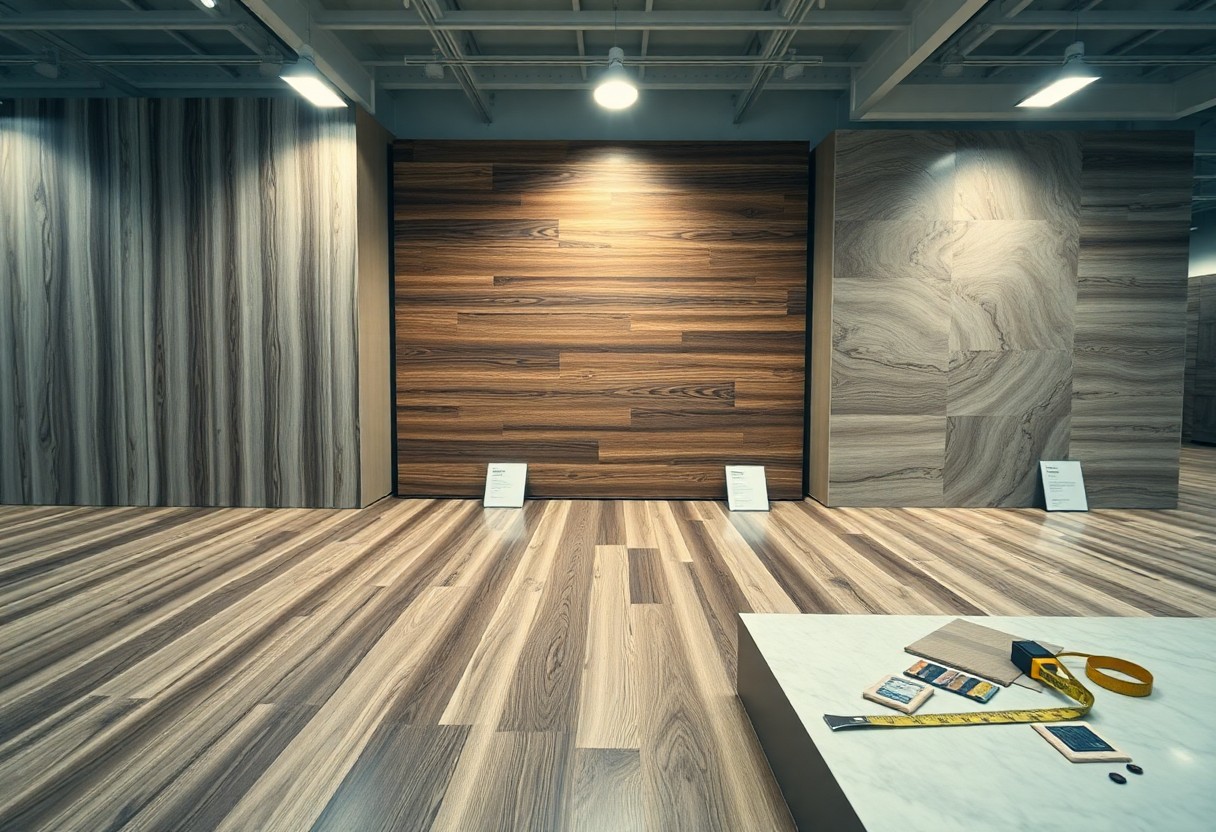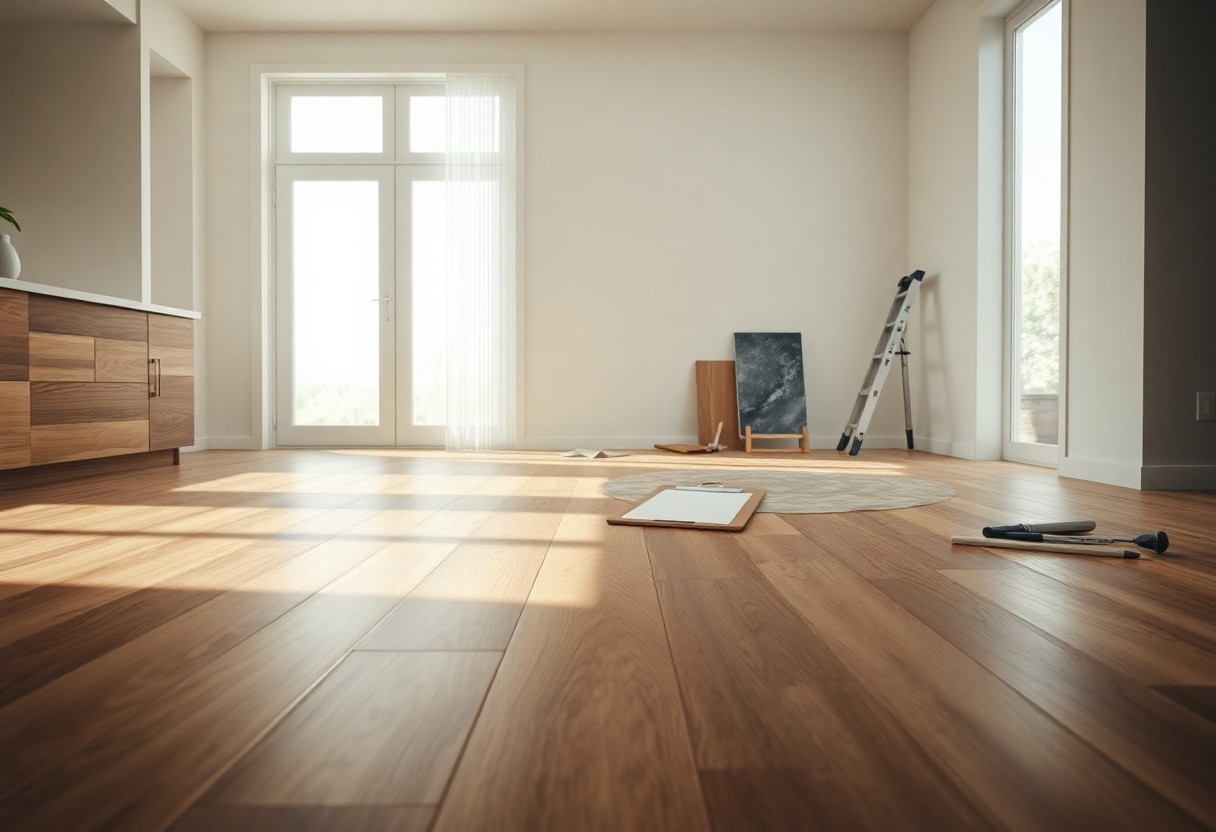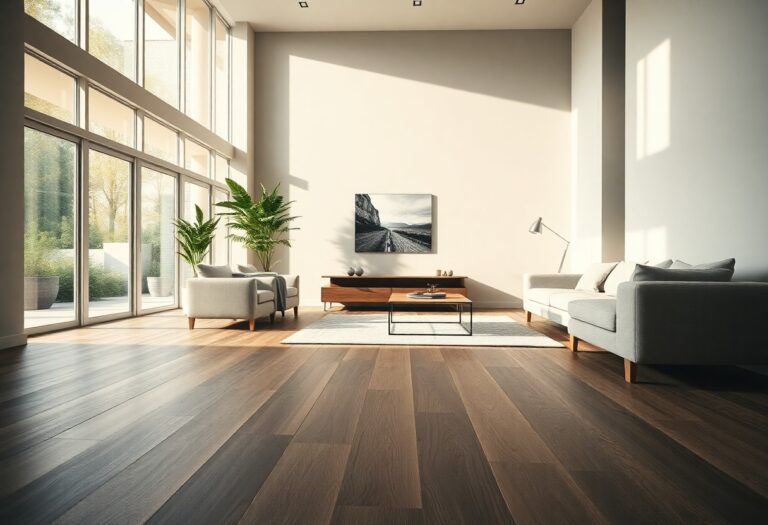Many homeowners face the challenge of selecting the ideal flooring option for their spaces, with laminate, SPC vinyl, and dry back vinyl all offering distinct advantages. Understanding the characteristics of each type will empower you to make an informed choice that complements your lifestyle and aesthetic preferences. In this guide, you’ll discover the key factors to consider, helping you find the perfect floor that matches your needs, style, and budget.
Understanding Floor Types
Choosing the right flooring type involves weighing several factors, including durability, aesthetics, and maintenance. Below are key distinctions to help you navigate your decision.
- Durability varies across options.
- Cost can significantly differ based on material.
- Installation methods range from DIY-friendly to professional required.
- Maintenance needs are important to consider for long-term satisfaction.
- The choice can affect your home’s resale value.
| Floor Type | Key Features |
|---|---|
| Laminate Flooring | Affordable, scratch-resistant, mimics wood. |
| SPC Vinyl Flooring | Waterproof, stone-plastic composite, durable. |
| Dry Back Vinyl Flooring | Glue-down installation, versatile designs, waterproof. |
| Environmental Impact | Varies by type, consider sustainable options. |
| Comfort | Varied underfoot feeling and sound absorption. |
Laminate Flooring
Laminate flooring is a versatile choice, often designed to replicate the appearance of natural materials like wood or stone. It’s resistant to scratches and dents, making it suitable for high-traffic areas. With a click-lock installation system, you can easily lay it yourself.
SPC Vinyl Flooring
SPC Vinyl flooring stands out for its robust, waterproof nature due to its stone-plastic composite core. This makes it an excellent option for moisture-prone areas like kitchens and bathrooms, while also providing a range of stylish finishes.
SPC Vinyl flooring is known for its stability and sound absorption, making it comfortable underfoot. Its thickness ranges typically between 4mm and 8mm, combining durability with an appealing aesthetic, thus making it suitable for both residential and commercial settings.
Dry Back Vinyl Flooring
Dry back vinyl flooring is installed using glue, securing it directly to the subfloor for a more permanent solution. This type provides a seamless look, reduces noise, and comes in various patterns, styles, and colors, enhancing your design options.
This flooring type excels in stability and can accommodate so many designs, offering an incredible range of customization for your space. While installation may require more effort compared to click-lock systems, the end result is a high-end appearance that is remarkably durable and waterproof.

Key Factors to Consider
Selecting the right flooring involves several key factors that will influence your decision. Focus on your lifestyle, the room’s purpose, and your long-term plans for maintenance and aesthetics. Prioritize the following:
- Durability and wear resistance
- Ease of cleaning and upkeep
- Visual appeal and design options
- Installation requirements and costs
This ensures you choose a floor that complements your needs.
Durability and Maintenance
Your floor must withstand daily wear and tear, especially in high-traffic areas. Laminate and SPC vinyl offer enhanced resilience against scratches, dents, and moisture compared to traditional hardwood. Choosing a flooring option with a strong wear layer can simplify cleaning and minimize maintenance needs.
Aesthetic Appeal
The visual aspect of flooring can significantly influence the ambiance of your space. Laminates are available in numerous styles and finishes, while SPC vinyl can mimic natural materials closely. Carefully consider color, texture, and overall design to align with your personal taste and existing decor.
With advances in technology, the aesthetic quality of vinyl and laminate flooring has improved dramatically. For instance, high-definition prints can replicate wood grains and stone textures, delivering a realistic look at a fraction of the cost. This variety allows you to be creative in your interior design, offering flexibility in achieving the desired atmosphere.
Installation Process
The installation process for flooring can vary significantly among materials. Laminates are often DIY-friendly due to their click-lock systems, while SPC vinyl may require special tools for a seamless fit. Adequate preparation of the subfloor is also necessary for ensuring longevity and performance.
Installing laminate or SPC flooring typically involves less mess and disruption compared to traditional hardwood or tile installations. Many homeowners opt for the floating installation method, which eliminates the need for adhesive and allows for quick adjustments. If you’re not comfortable with DIY projects, hiring a professional installer can ensure a flawless finish.
How to Assess Your Space
Before choosing flooring, evaluate your space to ensure you make an informed decision that suits your needs. Take into account the size of the area, layout, lighting conditions, and existing decor. This assessment will help you visualize how different flooring options will fit within your environment, leading to a harmonious design outcome.
Room Purpose and Usage
Consider how the room will be used. High-traffic areas, like hallways and living rooms, benefit from durable materials like laminate or SPC vinyl, while softer options may be more suitable for bedrooms. Align the flooring choice with your lifestyle; active households may require stain-resistant options for longevity.
Climate and Environmental Factors
Your climate greatly influences flooring selection. In humid areas, moisture-resistant materials, like SPC vinyl, are ideal to prevent warping, whereas dry back vinyl can be utilized in drier climates but may require additional underlayment. Adjusting for local weather conditions ensures your flooring retains its aesthetics and functionality.
- Assess humidity levels and temperature fluctuations.
- Consider exposure to sunlight, which can fade flooring.
- Understand your home’s insulation affecting temperature and moisture.
- Thou must adapt your choice to suit these variables.
For instance, if you live in an area prone to humidity and moisture, SPC vinyl provides the necessary water resistance while maintaining an appealing look. In contrast, dry back vinyl might not perform as well in these conditions. To further mitigate risks, ensure proper installation methods that complement your climate and enhance durability.
- Be mindful of subfloor conditions that may affect flooring performance.
- Gauge the potential for outdoor moisture infiltrating indoor spaces.
- Explore options with warranty coverage against environmental factors.
- Thou ought to select materials that withstand your unique climate profile.
Tips for Choosing the Right Material
Choosing the right flooring material involves assessing not only aesthetics but also functionality and practicality. Consider factors like your lifestyle needs, installation requirements, and the climate in your area. Ensure that you evaluate the long-term maintenance associated with each option, while also factoring in the space where the flooring will be installed.
- Evaluate your lifestyle and family dynamics.
- Consider moisture levels and temperature fluctuations.
- Assess the room’s foot traffic and usage patterns.
- Balance style preferences with practical needs.
- Investigate the warranty options available for each material.
Perceiving your needs holistically will guide you to the best choice.
Cost vs. Value
Your budget plays a significant role in flooring selection, but it’s imperative to distinguish between cost and value. Laminate options are often more affordable upfront, whereas SPC and dry back vinyl may offer better durability and longevity, potentially saving you money on replacements in the long run. Evaluate not only the initial price but also how well each material stands up over time relative to its maintenance and repair expenses.
Noise and Comfort Levels
When choosing flooring, consider how it feels and sounds in your space. Laminate can sometimes amplify noise compared to the quieter, softer feel of SPC and dry back vinyl, which often includes sound-dampening features. Choose materials that not only fit your aesthetic but also create a comfortable environment. Flooring with added cushioning can reduce noise levels and improve foot comfort, making your space more inviting.
The noise and comfort of flooring significantly impact your living or working environment. Laminate flooring often produces more echo, providing a less cozy atmosphere, especially in large areas. In contrast, SPC and dry back vinyl typically incorporate a softer underlayment that absorbs sound and provides a warmer, more comfortable walking surface. Additionally, these materials tend to feel more forgiving underfoot, which reduces fatigue during extended periods of standing. The right choice balances sound control and comfort, contributing to an overall pleasant ambiance in your home or office.
Installation Tips
Choosing the right installation method is imperative to achieving the best results for your flooring. Consider factors such as the type of material, your skill level, and the condition of your space. Here are some tips to keep in mind:
- Read the manufacturer’s guidelines carefully.
- Ensure you have all the necessary tools before starting.
- Take accurate measurements to avoid waste.
- Acclimate your flooring materials according to instructions.
- Maintain a clean workspace for safety and efficiency.
Recognizing the complexity of installation can help you decide the best approach for your project.
DIY vs. Professional Installation
You can choose to tackle the installation yourself or hire professionals. If you have experience with home improvement projects, DIY might save you money and provide satisfaction. However, for more complex layouts or extensive flooring, professionals ensure that the job is done correctly and efficiently, thus minimizing future issues.
Preparing Your Subfloor
Your subfloor must be in optimal condition before installing any flooring material. Start by removing any existing flooring and thoroughly cleaning the area. Ensure the surface is dry, level, and free of debris. In some cases, you may need to repair or replace sections of your subfloor to achieve a stable foundation, as imperfections can lead to issues such as warping or uneven wear over time.
Concrete and wooden subfloors require different preparations. For concrete, check for moisture and apply a moisture barrier if necessary. Wooden subfloors should be inspected for squeaks or damaged sections, which should be fixed accordingly. A level surface is vital; consider using a leveling compound if needed. Taking the time to prepare your subfloor properly will enhance the longevity and appearance of your new flooring.
Maintaining Your Floors
Effective floor maintenance is vital for prolonging the lifespan of your flooring, ensuring it retains its beauty and functionality over the years. Regular care will help you avoid costly repairs, maintain hygiene, and enhance the overall aesthetic of your space. Adopting appropriate cleaning and long-term care practices tailored to your specific flooring type can make a significant difference.
Cleaning Practices
For efficient cleaning, start with a dust mop or vacuum to remove debris and dust. Use a damp mop with a suitable cleaner for your floor type—avoid harsh chemicals that could damage the surface. It’s best to clean spills immediately to prevent staining, and always refer to the manufacturer’s guidelines for specific cleaning products and methods.
Long-term Care
Long-term care involves proactive measures to maintain the integrity of your floors. Place mats at entryways to catch dirt and moisture, and consider using furniture coasters to prevent scratches. Regularly inspecting your floors for signs of wear and addressing issues promptly can help maintain their condition and appearance.
To ensure optimal long-term care, schedule periodic deep cleaning and refinishing if necessary. For laminate, periodic sealing can protect against moisture, while SPC vinyl may require fewer treatments. It’s wise to establish a routine that includes cleaning and inspections at least once a season. Adapting your care methods based on your flooring type and the level of foot traffic in your home will ultimately lead to lasting satisfaction with your choice of flooring.
Summing Up
The choice between laminate, SPC vinyl, and dry back vinyl flooring hinges on your specific needs and preferences. Assess factors like durability, moisture resistance, and installation ease to determine which option aligns best with your lifestyle and space. Laminate offers a budget-friendly, stylish choice, while SPC vinyl provides superior resilience against water and wear, and dry back vinyl offers a versatile solution for various environments. By carefully evaluating these qualities, you can confidently select the perfect flooring that enhances your home for years to come.





